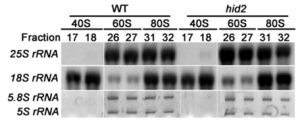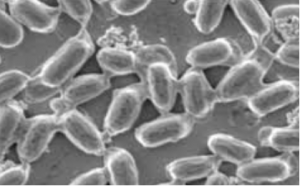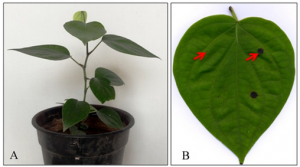|
GRASSY TILLERS1 (GT1) and SIX-ROWED SPIKE1 (VRS1) homologs share conserved roles in growth repression
Monday, 2023/12/25 | 08:04:12
|
|
Joseph P. Gallagher, Jarrett Man, Adriana Chiaramida, Isabella K. Rozza, Erin L. Patterson, Morgan M. Powell, Amanda Schrager-Lavelle, Dilbag S. Multani, Robert B. Meeley, and Madelaine E. Bartlett. PNAS December 14, 2023; 120 (51) e2311961120 SignificanceDuring plant evolution and domestication, some genes are repeatedly targeted by selection to sculpt development and influence crop productivity. For example, in maize, barley, and many other grass crops, grain production is affected by growth suppression in floral organs. This growth suppression is controlled by class I HD-ZIP transcription factors, which have been repeatedly selected to suppress growth, suggesting deep conservation of function. We found that HD-ZIP transcription factors GT1 and VRL1 regulate growth suppression in branching and flowering structures in maize and brachypodium. Our findings confirm that these two gene lineages share a conserved role in growth suppression and demonstrate how evolution and domestication can be used to predict strong gene editing targets for crop improvement. AbstractCrop engineering and de novo domestication using gene editing are new frontiers in agriculture. However, outside of well-studied crops and model systems, prioritizing engineering targets remains challenging. Evolution can guide us, revealing genes with deeply conserved roles that have repeatedly been selected in the evolution of plant form. Homologs of the transcription factor genes GRASSY TILLERS1 (GT1) and SIX-ROWED SPIKE1 (VRS1) have repeatedly been targets of selection in domestication and evolution, where they repress growth in many developmental contexts. This suggests a conserved role for these genes in regulating growth repression. To test this, we determined the roles of GT1 and VRS1 homologs in maize (Zea mays) and the distantly related grass brachypodium (Brachypodium distachyon) using gene editing and mutant analysis. In maize, gt1; vrs1-like1 (vrl1) mutants have derepressed growth of floral organs. In addition, gt1; vrl1 mutants bore more ears and more branches, indicating broad roles in growth repression. In brachypodium, Bdgt1; Bdvrl1 mutants have more branches, spikelets, and flowers than wild-type plants, indicating conserved roles for GT1 and VRS1 homologs in growth suppression over ca. 59 My of grass evolution. Importantly, many of these traits influence crop productivity. Notably, maize GT1 can suppress growth in arabidopsis (Arabidopsis thaliana) floral organs, despite ca. 160 My of evolution separating the grasses and arabidopsis. Thus, GT1 and VRS1 maintain their potency as growth regulators across vast timescales and in distinct developmental contexts. This work highlights the power of evolution to inform gene editing in crop improvement.
See https://www.pnas.org/doi/10.1073/pnas.2311961120
Figure 1: VRL1 enhances GT1 lateral growth repression. (A) Gene tree showing the evolutionary history of the GT1 (yellow box) and VRS1 (blue box) lineages of the class I HD-ZIPs. The black arrow points to the node at which the VRS1 and HvHOX2 lineages diverged. The gray arrows point to the nodes at which the maize-specific duplication led to the divergence of GT1 and GT2 and of VRL1 and VRL2. Stars highlight genes used in this study. Bootstrap support values are available in SI Appendix, Fig. S1. (B) Mutant lesions used in this study. For GT1, a Mu-insertion line and the previously described gt1-1 allele were used. For VRL1, a Mu-insertion line and a CRISPR mutant were used. An alignment of the wild-type VRL1 allele and the vrl1-CR allele is provided. (C) Tillering in maize plants, left to right: wild type, gt1, vrl1, gt1; vrl1. Colored outlines correspond to bar plot colors in panels D–F. (D) Quantification of the number of tillers per plant. (E) Quantification of tiller length per plant. (F) Quantification of the number of ears produced per plant. In D–F, DM = double mutant (gt1; vrl1), square = 2019 field, circle = 2020 field, triangle = 2021 field. Large shapes are year means, small points are individual plants. Different letters above bars correspond to significantly different means (Tukey’s HSD Test, P < 0.05).
|
|
|
|
[ Other News ]___________________________________________________
|


 Curently online :
Curently online :
 Total visitors :
Total visitors :
(142).png)



















